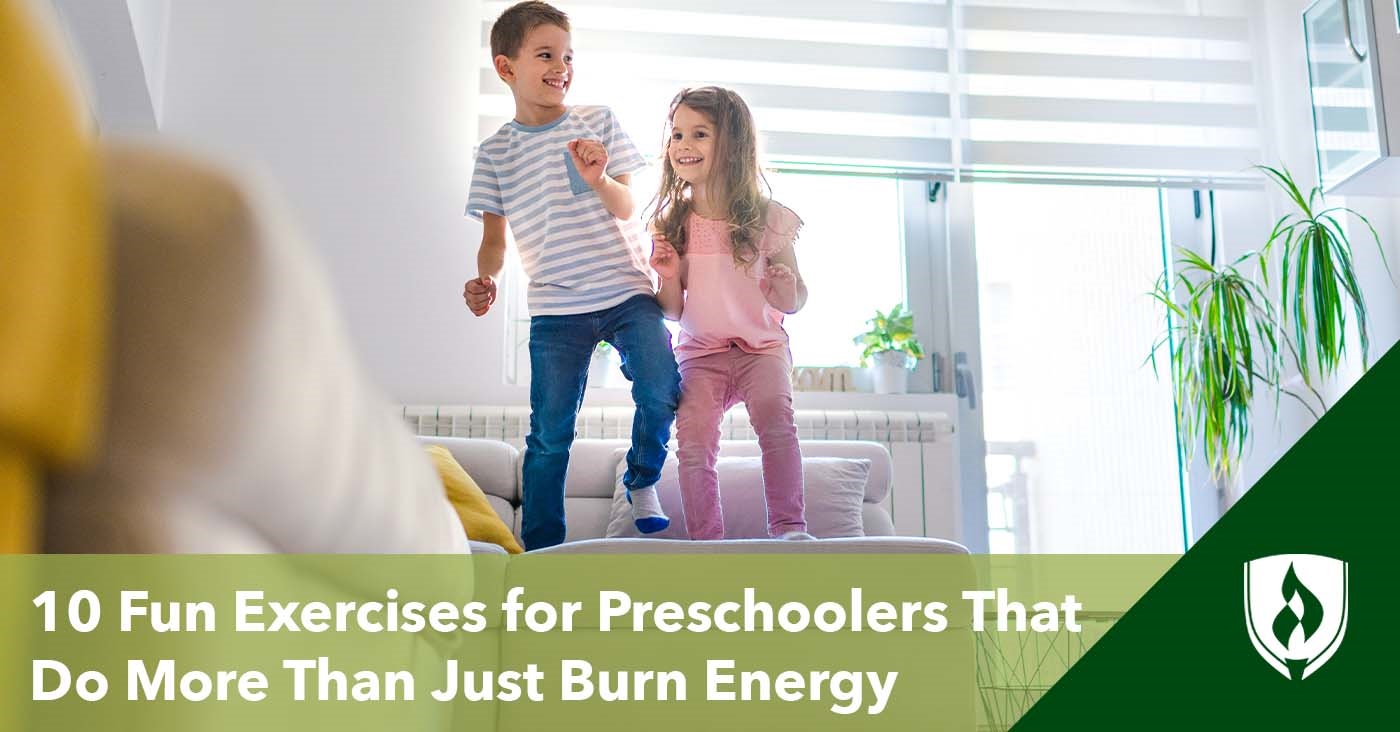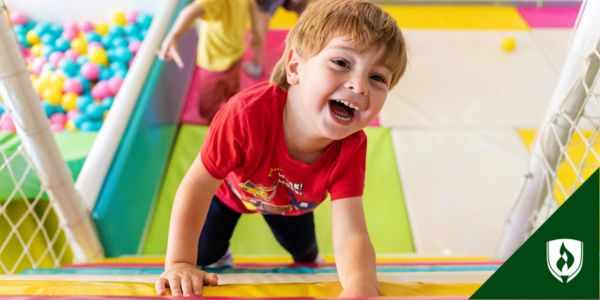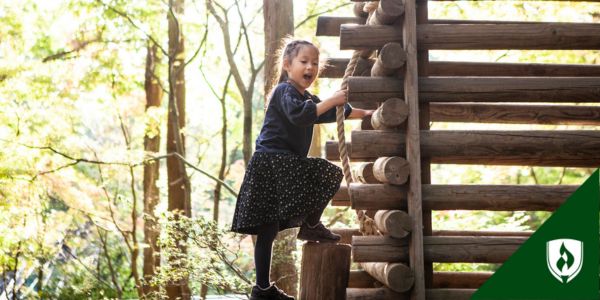10 Fun Exercises for Preschoolers That Do More Than Just Burn Energy
By Brianna Flavin on 09/20/2021

Preschoolers can be a lot. A lot of joy. A lot of mess. A lot of energy. And keeping them entertained can take a lot out of you. But one of the most amazing things about kids is how much they want to use that energy to further understand their world.
The development and learning they gain out of games and exercises that may seem simple to adults is staggering. Good preschool exercise is about so much more than tiring them out. “The role of physical exercise in child development is crucial to understand as more children are growing up ‘swiping’ rather than building, cutting, coloring, painting, squeezing or rolling,” says Kate Fraiser, parent coach and early childhood consultant.
Fraiser explains that children need to run, jump, climb, throw and catch to develop. “Seeing so many stationary young children who are not building large motor muscles should alert those who work with young children to learn to do things differently.”
If you are interested in checking out some exercises for preschoolers that also develop important skills, read on! We asked early childhood experts to share about what makes preschool exercise so valuable, along with some exercises and activities you can try with the little ones in your life.
Why does exercise matter in preschool?
One reason exercise is so important in preschool is the same reason it’s important in other walks of life: physical health. Exercise helps children develop strong bones, muscles and cardiovascular health. Exercise also helps children regulate stress and get better sleep at night. But at this critical age of development, exercise is also essential to develop motor skills, cognition and even social skills.
“People in early childhood education need to understand the importance of big body play for young children,” says Sandi Baty, director at the University of Northwestern Child Development Center. Baty explains that big body play involves the sorts of rough-and-tumble, large-muscle activities that children intuitively love.
Adults are often hesitant to allow preschoolers to play big because they are worried about potential injuries, Baty says. “But children need this physical activity for their bodies to release energy and allow their bodies to calm down at a later time.”
Exercises where children jump, tumble, roll, spin, swing, crash, tug, push and wrestle allow them to develop coordination and learn about their bodies, according to Baty. “They will also increase their social skills as they learn to play with one another.”
In many ways, preschool exercise needs don’t demand anything new. Many of the best exercises for preschoolers will look pretty familiar to you—as children have been doing them for ages! But sometimes understanding just how and why these games and activities are so important can be the key you need to get the little ones in your life moving in a big way.
10 Fun preschool exercise ideas
These ideas all provide great options for keeping kids in motion while still being a lot of fun.
1. The floor is lava
Pretending the floor is lava has fired up little imaginations for years! When preschoolers leap from pillow to pillow or clamber from the couch to a chair, their large motor skills get a super boost, according to Fraiser. As kids estimate jumping distances or invent new ways to stay off the “lava” floor, they develop coordination and cognition at the same time.
To make things even more exciting for their imaginations, add toys to different “pillow islands” that need to be rescued. Or give the preschoolers their own items to use as stepping-stones, and watch them create the obstacle course. Learning Resources® suggests different variations, like adding a countdown clock or paper stepping-stones with numbers and letters, to make the game challenging in new ways.
2. Hide and seek jail
Hide and seek offers children the chance to role play, work on large motor skills and practice risk. Early Impact Learning suggests this twist where the seeker brings each kid back to a “jail” space when they are found. If other hidden players sneak over, they can free anyone in the jail space and race to new hiding spots!
Role play is a great way for preschoolers to learn how to process stress in low-stakes situations. Hide and seek harnesses that childhood fascination with being hidden and adds even more dynamic movement.
3. Hit the target
Throwing is an important gross motor skill for preschoolers—and it can be easy to discourage indoors when a misfire could smash something. This game is ideal outside but can still work in a small indoor space. VeryWellFamily suggests marking a target on the ground or the floor. You could use tape, chalk, a pillow, a hat, anything. Then give preschoolers some bean bags or stuffed toys (or even a balled-up sock), and tell them to hit the target.
4. Sweeping and raking
You might be thinking: Isn’t this essentially offering them chores as play? The short answer is yes—but with a caveat. Since preschoolers are still at an age where anything adults do is interesting, why not take advantage of the amazing motor development these activities offer? And in reality, you’re likely going to be doing a little bit of clean-up of their own work.
OTMom explains that sweeping and raking build bilateral coordination and shoulder girdle strength. She recommends showing children how to hold the large broom handle since it is not intuitive to most kids. Then let them work next to you. Helping with household chores also offers psychological benefits, like confidence and social adaptation–and, if you dare to dream, potentially a cleaner environment!
5. Balloon tennis
This activity from Little Bins for Little Hands involves plastic fly swatters and a balloon (or many) and helps kids develop coordination and gross motor skills.
Blow up the balloon, give all participants a fly swatter, and have them hit the balloon back and forth—or simply focus on keeping the balloon in the air! This activity can be doable for even preschoolers on the younger side (you can allow the littlest ones to use their hands), and it’s pretty thrilling for the older ones too.
6. Move the large objects
“I like activities that involve heavy lifting to engage children’s muscles,” Baty says. Heavy lifting could be moving large blocks, shoveling snow or helping carry teacher’s supplies. “We have some old car tires on our playground that have been great for big body play with preschoolers.”
Baty watches children stack the tires, roll them, create tunnels and pile them to create space. “So much communication happens as they are directing others to help move them.”
7. Simon says 2.0
This classic mimicking game is excellent to help preschoolers develop self-control and concentration, according to Cheqdin Blog. They propose starting with the traditional “do what Simon says” approach, but then adding variations, like instructing children to do the opposite of what Simon says. This adds complexity to the game and helps teach mental flexibility.
Since it’s also easy to make the game physically dynamic, this is a great multipurpose exercise. For example, “Simon says, ‘Jump as high as you can!’”
8. Ice cube proprioception jump and smash
This activity from The OT Toolbox can get messy, but it’s great for preschoolers’ sensory development and motor skills. Proprioception is the name for your nervous system’s essential body awareness, developed by nerve receptors that feel resistance, pressure and a whole lot more.
To activate some of that good stuff, freeze water and a bit of food coloring in ice cube trays (or muffin tins for an easier target). Lay the colorful ice cubes out on a strong surface, ideally outside, and allow preschoolers to smash the ice with a hammer! To add the jumping element, scatter the colorful cubes, and have preschoolers jump over them or weave around them.
This activity could be a great choice if you live in a wintry climate and want an outdoor exercise.
9. Songs with hand motions
Exercises that combine moving and singing, like the classics, “If You’re Happy and You Know It” or “Head, Shoulders, Knees and Toes” make for a catchy, rhythmic way to burn off some energy. But they are also beneficial to develop cognitive abilities and motor skills in preschoolers. The simple melodies help those little brains focus on the activity—and will probably get stuck in your head for the rest of the day.
10. Unstructured play time with other preschoolers
Sometimes the best way to nurture preschool development is to just get out of the way. “I remember watching three preschoolers riding tricycles around the winding track of our outdoor play area,” Fraiser says. The children made up their own road rules and called them out. They laughed as they bumped into each other, passed out tickets for speeding and went to the store to “pick up groceries.”
“The imagination and communication they combined with their physical activity that day was joyful to observe,” Fraiser says. “They developed social skills of negotiating and enjoying a moment together. They used full body movements as they learned what their bodies could and couldn’t do. And they had no direction or interruption from adults. It was wonderful.”
Supporting preschoolers in their development
If you have little ones in your life, understanding the stages of their development is a vital way you can build them up. Check out “Experts Explain How to Support Kids Through the Stages of Child Development.” Another article you can check out " Toddlers and Technology: A Guide for Responsible Introduction to Devices" to learn how to responsibly introduce devices to your children.
And if child development is already a fascination of yours, maybe you are the kind of person who should spend more time around little learners. Check out “9 Signs You Should Be Teaching Preschool” to see if this role would suit you.
Learning Resources is a registered trademark of Learning Resources, Inc.
Related Articles:




